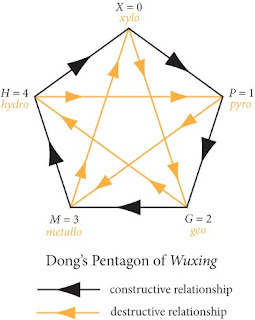Wuxing and Compatibility Coefficient: Part III
If the xing were to be arranged in a clockwise manner according to Dong's numerical order, we have the following pentagon of wuxing.
Interestingly, pentagon is the only polygon for which number of constructive relationship (number of sides) equals the number of destructive relationship (number of diagonals). This is easily proven since the only solution to the following equation:
is n = 5. Now, it is useful for a computer programmer to introduce a coefficient which can be used to compute the compatibility of any two given xing without having to refer to Dong's pentagon.
The three numerical values of compatibility coefficient cp (namely -1, 0, 1) are to be interpreted as destructive, neutral, and constructive, respectively. A convenient way to compute cp is to use the following equation:
For example, in the case of wood xing and fire xing, we have cp(0,1) = 1, a constructive relationship. In the case of fire xing and water xing, we have cp(1,4) = -1, a destructive relationship.
Interestingly, pentagon is the only polygon for which number of constructive relationship (number of sides) equals the number of destructive relationship (number of diagonals). This is easily proven since the only solution to the following equation:
is n = 5. Now, it is useful for a computer programmer to introduce a coefficient which can be used to compute the compatibility of any two given xing without having to refer to Dong's pentagon.
The three numerical values of compatibility coefficient cp (namely -1, 0, 1) are to be interpreted as destructive, neutral, and constructive, respectively. A convenient way to compute cp is to use the following equation:
For example, in the case of wood xing and fire xing, we have cp(0,1) = 1, a constructive relationship. In the case of fire xing and water xing, we have cp(1,4) = -1, a destructive relationship.







Comments